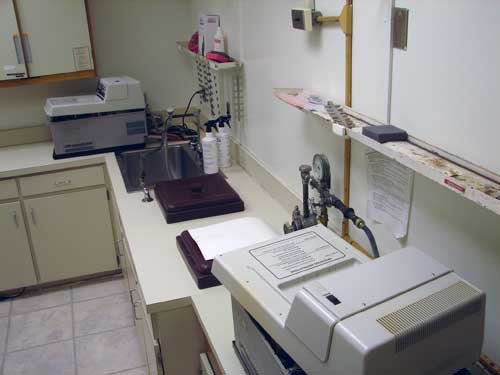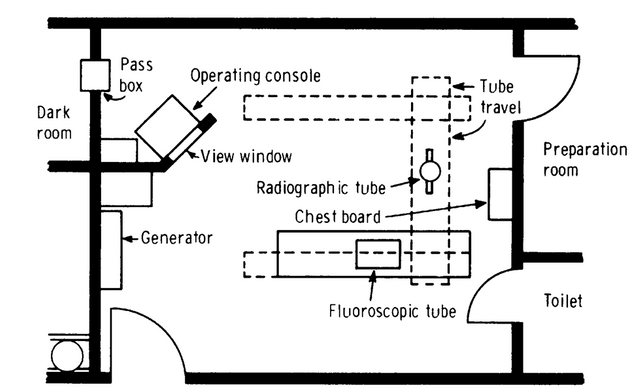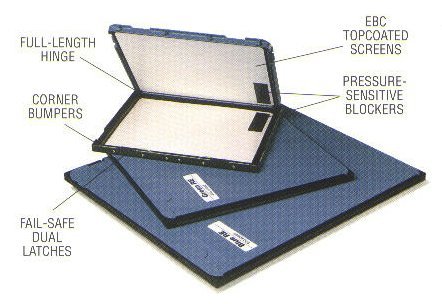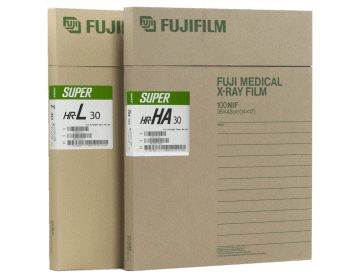Cassette Radiology& Dark Rooms.
- Dark Room.
Radiograph examination is one of the efforts of medical activities in diagnosing. The success of producing quality radiographs and having a radiographic aesthetic standard is influenced by various factors. One of them is the activity in the dark room during the processing of radiographic film.
Radiographic processing is carried out in a dark room starting from a dry area by inserting a radiographic film that has not been exposed (unexposed) to the cassette which is then exposed to the film. The next activity is unloading, which is to release radiographic films from the cassette to process radiographic films. While the activities carried out in wet areas are chemical film processing activities.
Because, so important is the dark room, then the things below are a little about the dark room that must be considered. Among others are :
- The function of the Dark Room.
A place to fill and remove films from cassettes.
A place to insert movies on the automatic processor.
Cassette maintenance, intensifying screen, and automatic processor.
Unexposed film storage area.
A place to make duplication and subtraction of films.
Place to do silver recovery.

2 Dark Room location.
2.1. Placed in a strategic place, so that it is easy to reach from shooting places.
2.2. Adjacent to the film sorting room.
2.3. Close to the archive room.
2.4. It is recommended for two photo rooms to be available in one dark room.
- Construction of Dark Rooms.
3.1. Size:
Area 3 X 3 m square with a height of 2.75 m
3.2. Floor.
Non-volatile ingredients.
Resistant to film washing liquids.
Not slippery, if the floor is wet.
3.3. Wall.
Bright colors.
Reflect light.
Easy to clean.
3.4. Palate.
Paint with a color that does not peel.

1.4. Dark Room Radiation Protection.
The wall thickness is equivalent to 2 mm Pb
Ordinary walls with a thickness of 20-25 cm
Cast concrete walls are 15 cm thick
The ordinary wall can be coated with a 2 mm Pb plate.
- Tools.
To protect x-ray films that have or have not been exposed, a device called a cassette is needed. Tapes, in the call, are always together with intensifying screens located in front of and behind the film. The cassette has a variety of functions, including:
Protecting the intense screen from damage caused by mechanical pressure, keeping the screen intensified from dirt and dust. In addition, the cassette also serves to keep the film tightly attached to the two intensifying screens located on the front and back of the cassette perfectly and limits scattering radiation from behind the cassette.
Tapes have various sizes. Among them are the size: (18 X 24) cm, (24 X 30) cm, (30 X 40) cm, (35 X 35) cm and (35 X 43) cm. The use of various kinds of tapes is determined by the object to be examined. For example is an examination of the astronomers. Because the object is small then for its efficiency it uses a cassette that measures (18 X 24) cm. As for the characteristics of the ideal cassette construction according to the standards that have been determined are as follows:

a) Strong and resistant to everyday use.
b) Light so as to facilitate storage and in sufficient lighting conditions, easy to open and close.
c) Have edges or angles that are not sharp so that they do not hurt patients or workers.
d) The front of the cassette does not affect the quality of the radiograph produced.
The back is coated with a layer of iron or Pb. So that it can reduce back scattering radiation from the back cassette.
The existence of a cassette with its functions will inevitably contribute greatly to the success of the radiodiagnostic examination. Therefore tapes must be maintained in such a way as to the possible damage. Damages to this tape often occur when the placement of tapes which are often used directly under the patient so that mechanical pressures occur. And tapes that accidentally fall and collisions that occur to him, are also the cause of the cassette experiencing dysfunction. This dysfunction can be seen when the cassette cannot protect the film from outside light, so fog will be produced on the radiograph. Of course, this finding will interfere with the resulting radiograph.
- Films.

Film is one of the most vital radiological equipment and is very sensitive to light and x-rays. This film, based on sensitivity and emulsions can be divided into two types, namely blue sensitive and green sensitive or often referred to as the film that has the characteristics of low speed and high speed.
Blue sensitive is often also known as monocromatic emultion, which is a type of film emulsion that is only sensitive to blue wavelengths. Seangkan green sensitive is often referred to as policromatic emultion, which is a type of film emulsion that is only sensitive to green wavelengths. The parts of the radiographic film will be presented as follows.
3.1. Basic film (film base)
The main material of the film base is made of polyester, and generally has a bluish dye (blue base). This base film has a thickness of approximately 0.18 mm.
3.2. Adhesive layer (subtratum layer).
3.3.1 Function of adhesive layer.
3.3.1.1. Paste the film emulsion layer evenly on a flat layer.
3.3.1.2. Prevent separation of film emulsion granules.
The material used for the adhesive layer is gelatin solution. Gelatin solution is a very complex protein composition that comes from collagen fibrous (fiber pieces) derived from cartilage, ruminant animal skin and obsession, which is then processed by hydrolysis so that the formation of gelatin polymer (NH2 CH2 COOH) is formed As for the properties of gelatin which benefit others:
a. Has a good bonding to silver halide granules.
b. At certain temperatures it is easy to compound with other solutions and if cooled it will harden again.
c. Does not affect silver halide, either after or before being irradiated.
d. If inserted into the processing process (generator) it will easily expand, so this gelatin will give other substances the opportunity to react.
3.3. Film emulsion.
The film emulsion is a "sensitive material" used to form a radiograph image. There are three types of halides commonly used. Among them are:
3.3.1 Silver bromide (AgBr).
3.3.1.1. Has a cut-off sensitivity reaching 480 nm. cut-off sensitivity is the wavelength limit of the film emulsion which shows the deadline for sensitivity.
Has a peak sensitivity reaching 430 nm. The peak sensitivity is the wavelength where the film emulsion shows at the most sensitive level.
Commonly used for making radiographic and photographic film emulsions.
3.3.2 Perak iodide (AgI).
Commonly used as mixed halides with the aim of increasing sensitivity.
3.3.3 Silver chloride (AgC l).
3.4. Protective layer (supercoat).
This protective layer is made of gelatin and serves as an antibration (wound or peeled).
Developer Solution.
The developer solution is a solution that functions to generate latent shadows into real shadows by reducing AgBr which is exposed to light into metallic silver. The reducing ingredients are as follows:
4.1. Metol.
4.2. Phenidone.
4.3. Hydroquinone.Rinsing.
Rinsing is the processing stage that is carried out between the generator solution and fixation which aims to remove the remnants of the generator solution carried by the film. There is also the material is water (not mineral water).Fixer solution.
6.1. Properties of the ingredients used:
6.2. Aim :
6.2.1. Stop the generation process.
6.2.2. Dissolve AgBr which is not reduced
6.2.3. Tan emulsion.Washing.
Washing is the processing stage that is carried out between the fixer and the drieng which aims to remove the remnants of the fixer solution from the surface of the film which if left unchecked will damage the image quality. This washing is the same as rinshing, which is water.Drying
Drieng is the last stage of the implementation of making radiographs. This draft serves to dry the cassette after washing.
"Warning: be careful of actions due to errors when certain times occur, prioritize your work safety because this x-ray zone is not ordinary radiation."
Good post. but unfortunately there is no references.
Ok.. Mohon maaf bila ada salah penulisan, maksud anda?
Sebaiknya dicantumkan referensinya bu @hilmicorel
Posted using Partiko Android
Ooo.. Source atau daftar pustaka, ok !!!!
benar bu. agar artikel ini berkualitas
Posted using Partiko Android
Thanks ... it looks like you have thighs with my post, I can guess that you are a radiographer. At least you graduate from D4-Radiology. I appreciate you. Help me if it's wrong, ok thanks ...@anroja.
You're welcome. Do you have a radiographic background too?
Posted using Partiko Android
Ohh ... no, there's no sir, I'm just an ordinary teacher, I still lack knowledge of radiology, sir. So, in the future the guidance so that I will be better.
Good wishes @hilmicorel,
Your post "Cassette Radiology& Dark Rooms." hast just been Resteemed !!! 😄😻😄
BY following us, You have earned our FREE Resteem service, which will increase your viewer.
😄😻😄 Best regards, free resteeme. @tow-heed🙃🙃🙃
Thanks.....
Nice post..!!!
Thanks...@hilmicorel..
Nice..post, i like it.. !!!! Good job @hilmicorel.